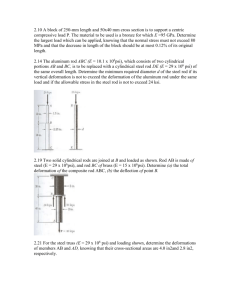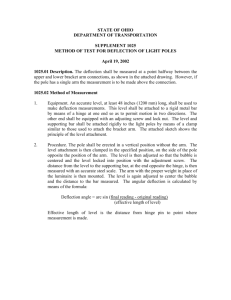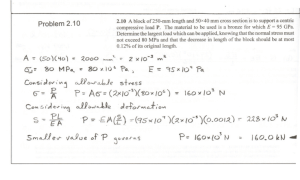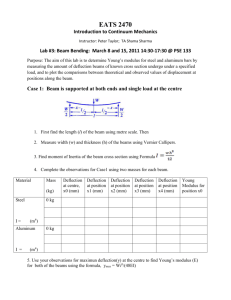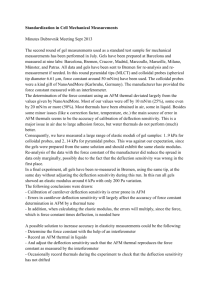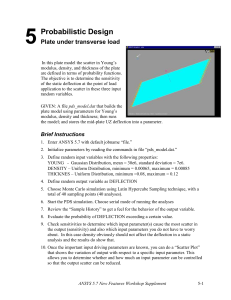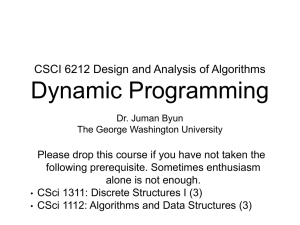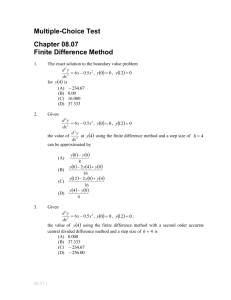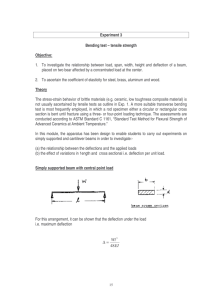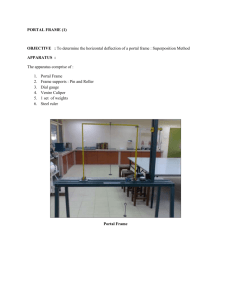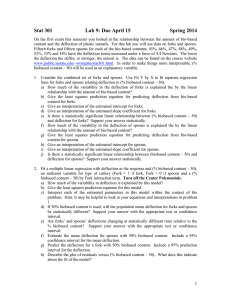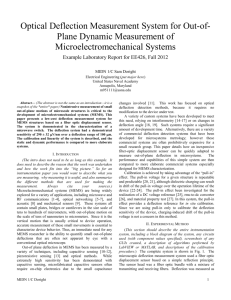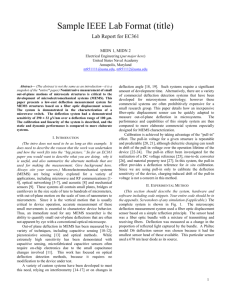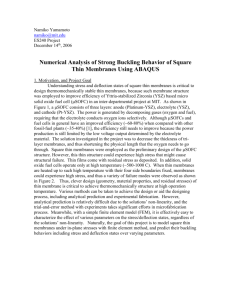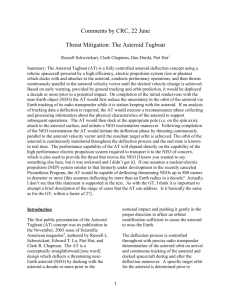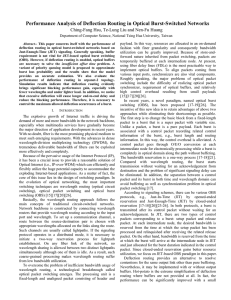the deflection of point B - Aero Structural Analysis
advertisement
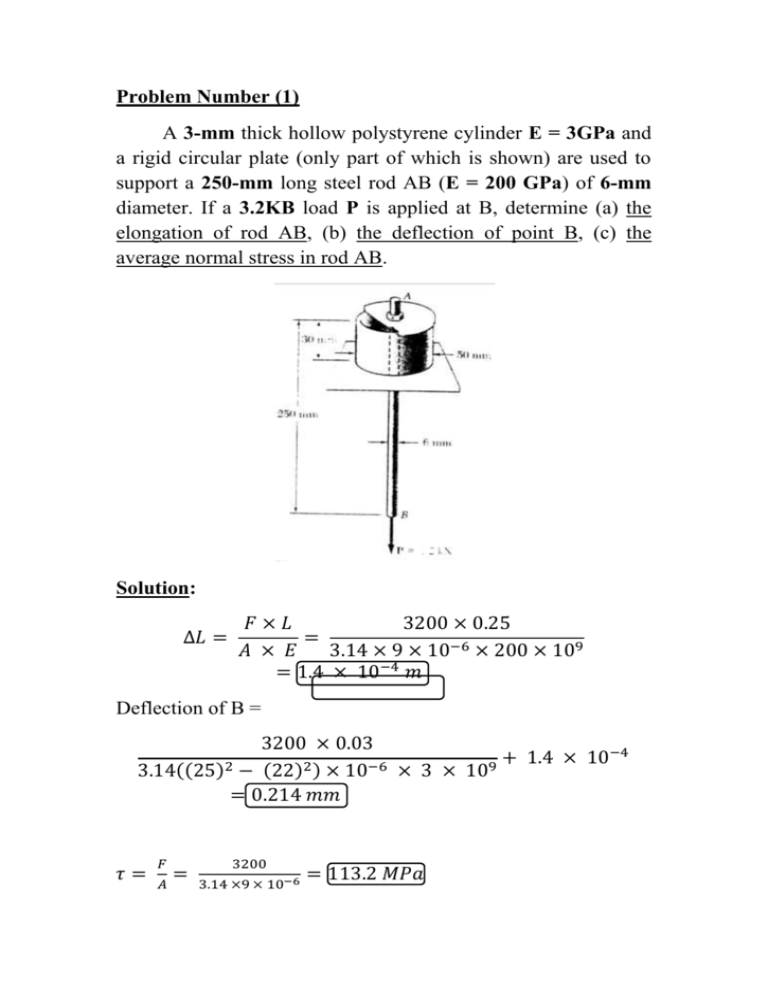
Problem Number (1) A 3-mm thick hollow polystyrene cylinder E = 3GPa and a rigid circular plate (only part of which is shown) are used to support a 250-mm long steel rod AB (E = 200 GPa) of 6-mm diameter. If a 3.2KB load P is applied at B, determine (a) the elongation of rod AB, (b) the deflection of point B, (c) the average normal stress in rod AB. Solution: ∆𝐿 = 𝐹×𝐿 3200 × 0.25 = 𝐴 × 𝐸 3.14 × 9 × 10−6 × 200 × 109 = 1.4 × 10−4 𝑚 Deflection of B = 3200 × 0.03 + 1.4 × 10−4 2 2 −6 9 3.14((25) − (22) ) × 10 × 3 × 10 = 0.214 𝑚𝑚 𝜏= 𝐹 𝐴 = 3200 3.14 ×9 × 10−6 = 113.2 𝑀𝑃𝑎 Problem Number (2) Two solid cylindrical rods are joined at B and loaded as shown. Rod AB is made of steel E = 200GPa and rod BC of brass E = 105GPa. Determine (a) the total deformation of the composite rod ABC, (b) the deflection of point B. Solution: Assume that the force 40KN is directed to downward at point B ∆𝐿 = 30 × 103 ×0.25 3.14 ×15 ×15 × 10−6 ×200 × 109 70 × 103 ×0.3 3.14 ×25 ×25 × 10−6 ×105 × 109 Deflection of Point B = 0.102 mm Problem Number (3) + = 0.393 𝑚𝑚 70 × 103 ×0.3 3.14 ×25 ×25 × 10−6 ×105 × 109 = Both portions of the rod ABC are made of an aluminum for which E = 70 GPa. Knowing that the magnitude of P is 4KN, determine (a) the value of Q so that the deflection at A is zero, (b) the corresponding deflection of B. Solution: ∆𝐿𝐵𝐶 = ∆𝐿𝐴𝐵 (𝑄 − 4000) × 0.5 3.14 × 0.03 × 0.03 × 70 × 109 4000 × 0.4 = 3.14 × 0.01 × 0.01 × 70 × 109 Then, Q = 32800 N Then, Deflection of B = 0.0728 mm Problem Number (4) (32800−4000) ×0.5 3.14 ×0.03 ×0.03 ×70 × 109 = The rod ABC is made of an aluminum for which E = 70GPa. Knowing that P = 6KN and Q = 42 KN, determine the deflection of (a) point A, (b) point B. Solution: Deflection of A = ∆𝐿𝐴𝐵 − ∆𝐿𝐵𝐶 = 6000 ×0.4 3.14 × 0.01 ×0.01 ×70 × 109 − (42000−6000) ×0.5 3.14 ×0.03 ×0.03 ×70 × 109 = 0.01819 𝑚𝑚 Deflection of B = (42000−6000)×0.5 3.14 ×0.03 ×0.03 ×70 × 109 Problem Number (5) = 0.091 𝑚𝑚 Each of the links AB and CD is made of steel (E = 200GPa) and has a uniform rectangular cross section of 6 * 24 mm. Determine the largest load which can be suspended from point E if the deflection of E is not to exceed 0.25 mm. Solution: ∑MB = P(375 + 250) – FDC (250) = 0 ∴ 𝐹𝐷𝐶 = 2.5𝑃 (𝑇𝑒𝑛𝑠𝑖𝑜𝑛) ∑Fy = FDC – FBA – P = 0 ∴ 𝐹𝐵𝐴 = 1.5𝑃 (𝑇𝑒𝑛𝑠𝑖𝑜𝑛) ∴ ΔCD 𝐹𝐷𝐶 𝐿𝐷𝐶 2.5𝑃 (200)(10)−3 = = (200)(10)9 (6)(24)(10)−6 𝐸𝐷𝐶 𝐴𝐷𝐶 = 1.736𝑃 (10)−8 𝑚 (𝐷𝑜𝑤𝑛𝑤𝑎𝑟𝑑) ∴ ΔBA 𝐹𝐵𝐴 𝐿𝐴𝐵 1.5𝑃 (200)(10)−3 = = (200)(10)9 (6)(24)(10)−6 𝐸𝐴𝐵 𝐴𝐴𝐵 = 1.0416𝑃 (10)−8 𝑚 (𝑈𝑝𝑤𝑎𝑟𝑑) From geometry of the deflected structure: ∴ Δ𝐸 = ( 250 + 375 375 ) ΔC − ( )Δ 250 250 B ∴ Δ𝐸 = (2.5)(−1.736𝑃)(10)−8 − (1.5)(1.0416𝑃)(10)−8 = −2.7776𝑃(10)−8 𝑚 For maximum deflection |Δ𝐸 | = 0.25𝑚𝑚 ∴ 2.7776𝑃(10)−8 = 0.25(10)−3 ∴P)max = 9.57 KN Problem Number (6) The length of the 2-mm diameter steel wire CD has been adjusted so that with no load applied, a gap of 1.5mm exists between the end B of the rigid beam ACB and a contact point E. knowing that E = 200 GPa, determine where a 20-kg block should be placed on the beam in order to cause contact between B and E. Solution:

